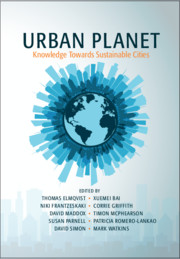Cities are an ancient form of human settlement. Successful ones continue to out-survive people, companies, cultural institutions, nonprofit organizations, and governments. The reason they do is because of their capacity to continuously adapt to the challenges particular to a place. Obviously, cities evolve differently based on their topography, natural resources, demographic composition, etc., but the real success of any city is especially dependent on one thing: connectivity. If a city’s land use, design, and planning enable connections between people – easing the transfer of goods, services, knowledge, and resources – then public policy decision-making and private investment will reflect local conditions, and the city will thrive. But if a city’s capacity to connect itself and operate holistically across sectors, communities, and jurisdictions is compromised, its viability is threatened.
Alas, over the last century, urban development in North America has been more informed by disconnection: land-use decisions were not properly connected to local knowledge; transit planning didn’t benefit from reliable data, which was either not collected adequately or held proprietarily; housing designs and locations were set without the insights of neighbors who knew the unique needs and attributes of their communities and what would fit best, and any regional environmental impacts from new development weren’t taken into consideration. The results from this disconnection can be seen in out-of-scale development that disrupts well-functioning streetscapes, expressways bifurcating vibrant commercial corridors, and public housing cited on flood plains. Sadly, the urban development mistakes committed over the last several decades in North America are being potentially repeated, as the Global South also rapidly urbanizes.
Were these development mistakes the result of a lack of knowledge? I doubt it. What continues to be lacking are reliable vehicles for locally generated knowledge to be incorporated into the decision-making processes that affect city livability. Will technology make it easier to ensure that decision-making affecting the built environment is informed by local knowledge? Proponents of big data and smart cities are suggesting yes. Perhaps, but only if they enable the sharing of tacit knowledge and hyper-local expertise, to produce place-specific innovations. These are tools, a means, not an end, for enabling agents within the city to communicate, collaborate, and codevelop. The proliferation of data and technology, advanced by private interests, also carries the risk that once again city leaders will be seduced by the promise of a “grand solution”, this time to make your city “smart” or “data rich.” Just as before when expressways, or large public housing developments were embraced as the latest universal big idea to solve an urban problem, we must be very wary of large-scale solutions that smother local knowledge and stifle innovation that is particular to place. Better data are valuable. But a smarter city is only that if it makes possible integrated decision-making that breaks silos, addresses policy fragmentation, and applies any new information in fundamentally innovative ways.
Communities know what makes their neighborhoods work well, as well as what inhibits them. The New Orleans Community Data Center (www.datacenterresearch.org/) demonstrated this after Katrina, identifying data gaps and local information sources, which proved critical to the city’s advocacy for recovery investment. Boston’s Office of Urban Mechanics http://newurbanmechanics.org/ and New York City’s Civic Hall http://civichall.org/ are other examples of local entities that are providing a bridge between local urban challenges, knowledge and opportunities for innovation. Looser alliances in cities that connect people across sectors are also important to building knowledge, such as Future Capetown (http://futurecapetown.com/), the Bandung Creative City Forum (http://bandungcreativecityforum.wordpress.com), and Toronto’s Civic Action (http://civicaction.ca/).
To be lasting and effective, we need multiple forms of bespoke urbanism. Outsiders have too often mistaken the complex weave of neighborhood exchange and improvization, that in fact make things work in a place, as examples of inefficiency and backwardness. But in fact, these patterns have evolved over time and work brilliantly within their local context. The determination of their effectiveness must be assessed locally, as should potential “fixes” to anticipate any unintended consequences. Contemporary city builders should observe the Hippocratic Oath, which reflects the Latin adage Primum non nocere (“First do no harm”) when venturing into communities to ”improve” them.
Various technologies have the potential to strengthen the city, but it is the particularities of a place, derived from local knowledge, practice, preferences, and culture – which will make it livable, sustainable, and real. Cities need innovations that connect to the local.



